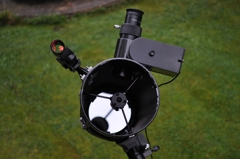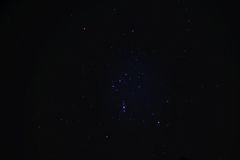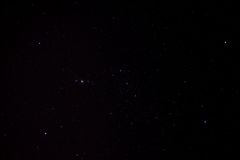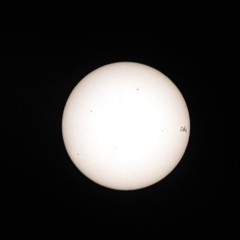It is imperative when photographing solar eclipses or transits to use a proper solar filter so as to prevent destroying the sensor on your camera and your eyes.
The eclipse and transit images were made using filter made from Baader AstroSolar Safety Film.
It was purchased from First Light Optics - www.firstlightoptics.com
It is not cheap, but it is significantly cheaper than replacing the sensor on a camera and the loss of your sight
|
 |
 |
|
|
September night sky.
The exposure time was 516 seconds.
Note the light pollution.
Note the star Polaris, about which all of the others appear to rotate. |
Jupiter and its moons.
Taken with a 450mm equivalent telephoto lens. |
|
|
 |
 |
 |
|
Partial eclipse of the sun 20th March 2015.
The picture shows the maximum that the sun was obscured.
Taken with a 450mm equivalent telephoto lens. |
Partial eclipse of the sun 20th March 2015.
Taken with a 450mm equivalent telephoto lens. |
Partial eclipse of the sun 25th October 2022.
Taken with a 450mm equivalent telephoto lens. |
|
 |
 |
 |
|
Reflecting telescope.
The mirror has a focal length of 500mm. |
Reflecting telescope.
Note the eyepiece, focussing mechanism and spotting scope. |
Reflecting telescope.
Note the mirror, eyepiece and spotting scope. |
|
 |
 |
|
|
Transit of mercury 9th May 2016.
Mercury is the dot in the lower half of the image.
The other dots are sun spots. |
Transit of mercury 9th May 2016. |
|
|
 |
 |
 |
 |
Full moon.
Note the craters at the edge of the moon image.
Taken with a 450mm equivalent telephoto lens. |
Just after full moon.
Note the craters at the edge of the moon image.
Taken with a 450mm equivalent telephoto lens. |
Super moon 14th November 2016.
Super - closest to the earth.
Taken with a 450mm equivalent telephoto lens. |
Super blood blue moon. 31st-January 2108.
Super - closest to the earth,
Blood - sunlight shining through the earth's atmosphere - lunar eclipse seen elsewhere,
Blue - second full moon in a month.
Taken with a 450mm equivalent telephoto lens. |
 |
 |
 |
 |
Super blood wolf moon eclipse 21st January 2019.
'Wolf' moon because it is the first of the year when wolves are meant to howl a lot!
Taken with a 450mm equivalent telephoto lens. |
Crescent moon.
The shadows created by the sun help to make the craters more visible.
405mm equiv. lens, f5.6, 1/320s |
Lunar eclipse, 13th August 2022.
Taken with a 450mm equivalent telephoto lens. |
Partial lunar eclipse, 23rd May 2023.
Taken with a 150mm equivalent telephoto lens. |
 |
 |
 |
 |
| Orion constellation, 35mm lens, 50mm equiv., f1.8, 1.3s |
Orion constellation, 60mm lens, 90mm equiv., f2.8, 3s |
Orion's belt, 300mm, 450mm equiv., f5.6, 3s |
Orion nebula, 300mm, 450mm equiv., f5.6, 3s |
 |
 |
 |
 |
| Venus with con trail, 105mm equiv. lens, f6.3, 1/160s |
Crescent Venus, 450mm equiv. lens, f5.6, 1/2000s |
Mars 52mm equiv. lens |
Mars 450mm equiv. lens |
 |
 |
 |
|
| Jupiter and Saturn composite, 450mm equiv. lens |
Jupiter and moons, 450mm equiv. lens |
Saturn, 450mm equiv. lens |
|
 |
 |
|
|
Large sunspot responsible for solar storm on 100524
300mm lens and solar filter |
Large sunspot one day later showing rotation of the sun |
|
|

